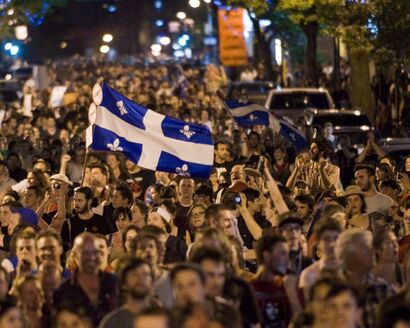Bettencourt Protests
| Bettencourt Protests | |||
|---|---|---|---|
| Part of Mayotte independence movement | |||
 | |||
| Date | October 1st - December 3, 2020 (2 months and 2 days) | ||
| Location | Blythe, Alutia, Auckandia, Titania, Bettencourt, Antirault, Ballycommon, Westven, several more cities in Eastern Zamastan | ||
| Caused by | |||
| Goals | Independence for Mayotte, end of political corruption, economic reforms | ||
| Methods | Peaceful protest, sit-in, occupation, picketing, strikes, riots | ||
| Resulted in |
| ||
| Parties to the civil conflict | |||
| |||
| Lead figures | |||
The Bettencourt Protests, also known as the Bettencourt Movement, was a series of protests during October to December of 2020 against limitations of the autonomy of the province of Mayotte, but quickly turned into a rallying cry for the long-sought independence of the Eastern Zamastanian provinces of Mayotte, Aunistria, and Alutia. The number of people taking part in the demonstrations were estimated at between 1.1 million (according to the local police) and 1.5 million (according to the organisers).
Pro-independence parties such as Bloc Mayotte and the Separatist Alliance Party seized on the opportunity of Moreau's presidency to further their cause for independence. President of Zamastan Atticus Moreau, who during the presidential campaign had promised not to endorse secession, prompted the governors of each province (Thomas Bonhomme, MA; Moses Luna, AN; Stephanie Morente, AL) to hold their own referendums. This move, although popular in the provinces seeking independence, caused widespread outrage across the rest of the country. On December 4th, Mayotte overwhelmingly voted to secede from the republic, followed on December 6th by Alutia and Aunistria. A similar referendum was attempted in Titania, but did not pass. Congressional Hall attempted to block the referendums, declaring them unconstitutional, but the Supreme Court of Zamastan intervened and ruled in favor of the provinces in a 7-2 vote on December 12th, with Chief Justice Roosevelt Dunn citing "provincial rights and priviledge" as the reason for upholding the referendums.
The provinces, now headed for fully autonomous governments, remained Zamastanian dependencies for the remainder of the year. On January 1st, 2021, the three provinces formally became independent forming three new nations of Mayotte, Auraine, and Alutiana. The governors at the head of the movement subsequently became the heads of state for their respective nations, and federalization of the provincial governments began. The Bettencourt Movement, beyond being a culturally momentous event for the secessionist states, had significant impact in Zamastan. The sudden split of the country dramatically cut the size of Congressional Hall and forced a reassesment of the federal government. The movement was also a major factor in President Moreau's sharp decline in popularity, and was instrumental in his decision not to seek reelection in 2022.
